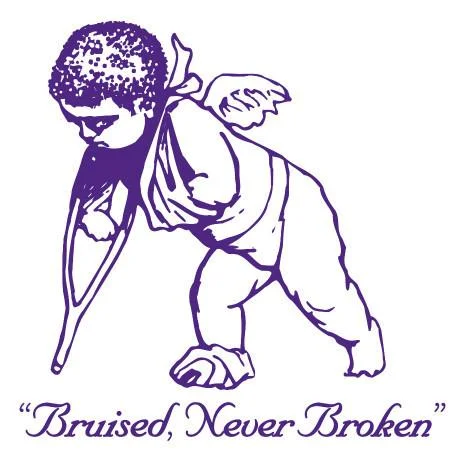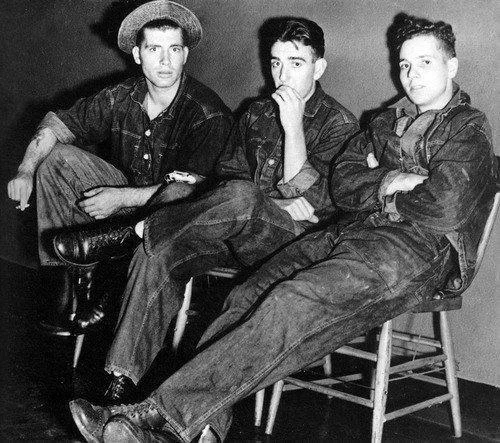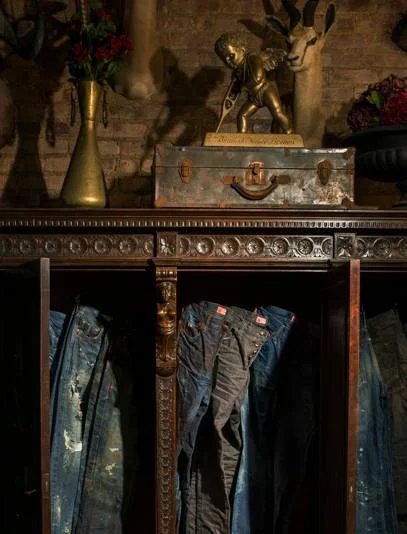Ornette Coleman
Vivien Goldman has been writing marketing material for jazz innovator Ornette Coleman for several years.
She authored the website for the lavish commemorative box set
‘CELEBRATE ORNETTE’
Alexander McQueen
McQ Fanzine
‘Neon is the New Navy Blue’
Prps: The Cherub
May 1, 2016
There’s quite a few Prps tattoos around – and the image people most often choose is our symbol the wounded Cherub, getting about on crutches but still smiling.
That cherub, concept and execution, sprang from the nimble 2HB pencil of our Founder, Donwan Harrell, who happens to be an actual, real artist; not even the conceptual type who can blow your mind without you understanding what they’re saying, but the old-school type of artist, an actual guy who can sit down anywhere with some lead and a pad, and make the page jump alive with his vision.
Though already a leading designer, finding a logo for the new PRPS brand, a very personal project for Harrell, was more challenging than usual. As it so often does, his mind turned to vintage cars, particularly Nascar’s daring ’69 Daytona, so wildly innovative that it proved impossible to drive on regular streets and soon became extinct. But its protuberant aerodynamic oblong rear “wing,” designed to slow air drag, continued to intrigue fans. Something about the wing’s stubborn panache echoed through to Harrell as a resilient winged cherub. We all have an angelic side, but sometimes circumstances invite the demon in us to step forward. Yet though it’s tested, even sometimes overshadowed, that inner angel still hangs on in there – bruised but not broken, as our Motto says.
But even beyond the race cars, the Cherub expresses our core beliefs – perfectionism, persistence, and purpose. Admiring the way its makers had adapted household rivets to fix the pockets of some ancient jeans, Donwan noted, “It’s more valuable bruised but present than when it was crisp and new. Just like the human spirit...and our Cherub.”
Prps: The Denim Whisperer
May 25, 2015
Jeans are supposed to be sturdy, but who knew they’d survive for centuries, stuffed into attic walls? A real-life Grizzly Adams, The Denim Whisperer (who prefers to stay nameless,) is a successful businessman who shares his compadre Donwan’s denim obsession. D.W. made a life-changing discovery while gutting a Midwestern fixer-upper – he pulled jeans dating back two hundred years out of crumbling brickwork, where it had been used as insulation.
As well as the stains and tears of long-gone toil, mice had chewed some of the denim into lace; but still, the jeans miraculously survived, in all their tattered defiance of time and the elements.
The workmanship and ingenuity that went into these prototypical working men’s pants were a revelation. These jeans were like the Rosetta Stone, unlocking the deep secrets of denim manufacture when tailors were inventors, making it up as they went along from whatever they could find.
The Denim Whisperer started his search in earnest and began combing industrial and rural areas for the oldest buildings. Most homeowners were amazed to discover that work clothes which their great-grandparents might have worn, were still being used in the roof to keep the damp out. Stored in the Prps archive of rare denim, their faded glory inspires all our jeans.
Prps: Re-inventing Denim’s Legacy…
August 13, 2014
Lovers of the pleasingly perverse, consider this: PRPS is to regular denim as a fine-cut diamond is to an unpolished gem. Each has its value, significance and power – but the fine-cut stone sparkles brighter.
The level of dedication and craft that goes into PRPS NOIR jeans, our bespoke collection, and all our jeans, may seem a great irony – all that costly art and skill lavished on what began as basic workers’ dungarees. Yet the rigorous spirit that propels us at PRPS and to which all our jeans pay homage is that of the first denim tribe: the late 19th century American workers, men who set out to pan for gold and battle bears, lay the rails and ride them; and the tailors who followed them, to stitch serious workwear by candlelight. Their life was a struggle, but they were determined. Every unique PRPS button and whiskering, the originality in our chemical replication of vintage washes, all reflect our respect for the originators of the jeans industry. Many of the men who built the jeans business were new Americans -- East European Jewish and Chinese immigrants escaping poverty and oppression in their homeland; not so different from today, then.
With all our love of the past, PRPS add innumerable levels of complexity and sophistication to the original, primitive process of making men’s denim wear.
The aged rips and stains that PRPS evoke in our original denim treatments, happened by chance. Such is life. In fact, the essence of what drove competition between jeans manufacturers –how to add durability to garments subjected to grueling conditions by strengthening stress points – also sprang from one fellow’s bright idea as he was tinkering at his workbench.
Jacob Davis, a tailor in Reno, Nevada, was making a special commission of extra-large pants when the tools of another job still lying out on his workplace caught his eye – some brass rivets. The brainwave to mix the two jobs by riveting the fabric was to transform his life and the world’s wardrobes. By such unforeseeable synchronicities, destinies are changed; when Davis’ reinforced “waist overalls” began selling fast, he sought help from a dry goods merchant who had supplied him with the white duck cotton he used – one Levi Strauss of San Francisco, a fellow Eastern European immigrant.
Together, the patent they claimed in 1873 ensured their supremacy in the competitive men’s workwear market for seventeen years, until it expired and denim frenzy began. Many jeans brands sprang up as denim pants became workmens’ default dress. After the Second World War, when a strange new cadre known as teenagers first formed, jeans were suddenly not rural, industrial and class-specific, but racy. Juvenile delinquents never wore anything else, as James Dean reminds us. The social democratization of the 1960s made jeans a sartorial common denominator; in the 1970s, American punks wore little else. As befits the Greed decade, designer jeans denoted the 1980s; by the 1990s, few Americans remembered there was anything other than jeans to wear and Casual Fridays infiltrated denim into staid boardrooms. High fashion designers dabbled in denim.
But by the time of the new century, it seemed like every cut was explored: baggy, tight, hipster, high-waisted. Where could jeans go, now that they’d been a staple for most of the planet, for almost a century?
Aficionados were ready for a different sort of statement. Experimental, attitudinal jeans, but still with the ever-ready, confrontational attitude of classic denim. New technological innovations couple with the durable qualities we demand of jeans.
The imperatives of denim are sober qualities. The art is in how the form follows the many rigorous functions jeans are subjected to daily. But man’s need for jeans has moved beyond the pure demands of labor. Now aesthetics and choice were required.
It is no accident that the next generation of jeans sprung from the PRPS axis of East and West, ancient and modern. Demonstrating a level of thought and artistry never before seen in denim, PRPS jeans reference not only denim’s hallowed, earthy past – but future directions for a garment that happened by happy accident.
Marley Natural
Examining Irie Livity & Wellness Through Bob Marley’s Eyes
Strawberry Hill Hotel: Luxury Jamaican Resort
Marketing copy for Strawberry Hill Hotel’s website





